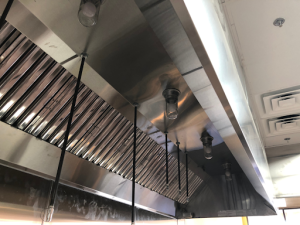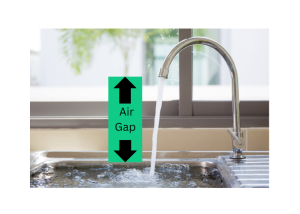73 11.6: Facility Systems
Hoods and Ventilation Systems

Commercial Hood Ventilation System
An adequate ventilation system is required to prevent grease and condensation build up on the walls, floors and ceilings of the facility. Accumulation of grease on surfaces could result in a fire hazard. Ventilation systems must be properly cleaned regularly to prevent grease or condensation to drip onto food or food contact surfaces resulting in biological contamination.
Food and food equipment should not be placed under water or sewer pipes. Leaks in overhead pipes can be a source of contamination and should be avoided in food prep and storage areas. Only licensed plumbers should install, repair and maintain plumbing equipment. Only chemicals approved for commercial food service should be used in the plumbing systems.
Water temperature should be measured regularly to prevent scalding. The water in faucets used for handwashing should not exceed 115F (46.1C) to prevent the risk of injury. Water used for laundry or dishwashing needs to reach higher temperatures to sanitize properly. When water evaporates, a white chalky residue can be left on equipment. This is a scale buildup and is an indication of hard water. The scale buildup can clog pipes, harbor microorganisms and reduce equipment life. A delimer can be used to remove the mineral buildup, referred to as descaling.

The air gap between the faucet and the sink rim
Local regulatory agencies provide information on grease trap, or grease interceptor, requirements. Depending on the type of facility, the local regulatory agency will provide the requirements for types and sizes of grease traps. A grease trap is installed to catch any fats, oils, and greases (FOG) before it reaches the sewer system. The grease trap is a container that allows the FOG to rise to the top and water to sink to the bottom. The water then is drained off into the sewer system, free of FOG. As FOG accumulates in the grease trap over time, it must be pumped out regularly by a waste removal company.
Effort must be made not to create a cross connection. A cross connection is when safe, potable drinking water is connected to unsafe, non potable water. Two ways to prevent a cross connection is (1) to have an air gap between the potable output device and the non potable containers or (2) to install a backflow prevention device on potable water lines.
Electrical Systems
Only licensed electricians should install, repair and maintain electrical equipment. Equipment with frayed or damaged cords should not be used as it could pose a safety hazard. Cords should be secured and not a tripping hazard. Follow all guidelines provided by the equipment manufacturer.
the water supply and distribution pipes; plumbing fixtures and traps; soil, waste, and vent pipes; sanitary and storm sewers and building drains, including their respective connections, devices, and appurtenances within the premises; and water-treating equipment.
to remove the mineral buildup from hard water
is commonly found in food and kitchen waste. When poured down the drain, it can solidify in sewer pipes, leading to blockages and potential overflows of wastewater.
when safe, potable drinking water is connected to unsafe, non potable water.
